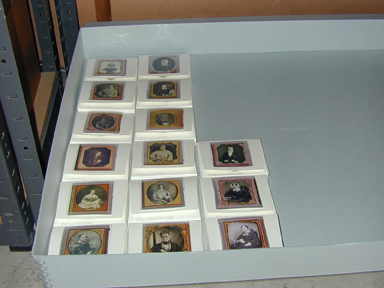This fall, Laura Reece, an Art History/Arts Management major at the College of Charleston, completed a semester-long internship with the Gibbes. Over the course of twelve weeks, Laura worked with me (the Collections Manager) on a variety of projects including cataloging and photographing new acquisitions, entering information in the collections database, conducting research on artists and assisting with installation of the exhibitions, Daufuskie Island: Photographs by Jeanne Moutousssamy-Ashe and Brian Rutenberg: Tidesong.

Laura also worked on what has been a multi-year, multi-intern project involving the Gibbes collection of cased photographs. The collection contains over 100 examples of early photography including daguerreotypes, ambrotypes, and tintypes. These kinds of photographs were usually enclosed in miniature cases made of wood with tooled leather covers. Cases protected the images from light, moisture, and abrasion and allowed the photographs to be easily and safely transported. Over the last three years, interns have diligently worked to better preserve and document these exceedingly rare photographs. Previous interns meticulously cataloged each item and entered the information into the collection database. Each piece has been photographed and attempts have been made to identify the original photographer. For her part, Laura was asked to create custom flap enclosures (made of archival board) for each photograph. Prior to this project, photographs were stored loose in archival boxes. This storage method was not ideal as cases tended to shift each time a box was moved. Cases also needed to be opened to see the image which required frequent handling and stress on already fragile objects.

Laura was given a general template for making the storage enclosures. However, cased photographs come in many sizes which necessitated creative thinking and a little math!

Once the custom housings were complete, each photograph was stored safely within the flap enclosure. Laura added the catalog number and an image to the front of each box for easy identification.


Enclosures were stored flat in wide archival boxes to prevent shifting and eliminate the need for stacking.

The end result is extremely satisfying to a Type-A Collections Manager such as me. The photographs are secure, organized, and can be easily identified with little handling. If we pay attention to how an object is handled, displayed, and stored, it truly can mean the difference between preserving it for many years or for only a short time. I am hopeful that our Gibbes interns have added many years to the preservation of this unique collection.
Published March 25, 2010

